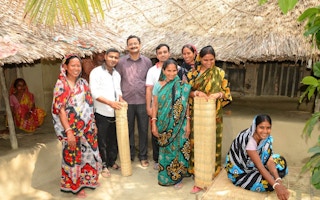Near the Sundarbans, Bangladesh, home to the largest mangrove forest in the world, Promila makes her living by making mats out of a grass-like wetlands plant called ‘reed’. Depending on size, these mats are sold at US$1 to $7 through a community enterprise established by Promila and her friends.
Thanks to the reed mat business, Promila and over 100 other women in her community no longer have to rely on collecting shrimp and fish – hence reducing pressure on the Kholpetua river.
Besides playing a role in mitigating climate change, the mat business has also brought about social benefits. The women now have a new-found confidence that enables them to negotiate prices directly with customers, while maintaining fruitful working relations with shopkeepers.
Implemented through Mangroves for the Future (MFF), an International Union for the Conservation of Nature (IUCN) partnership-based coastal programme, this alternative livelihoods initiative in Bangladesh is an example of a conservation intervention designed to conserve biodiversity by substituting one livelihood activity that causes harm to a species or a habitat with another activity that causes less harm.
Nature-based solution
In just a few decades, reccurring heat waves, rapidly rising sea levels, and more intense droughts, wildfires, and floods, are clear signs that our planet is experiencing a serious upsurge in climate change.
To tackle this existential crisis, there are two solutions that we can consider: the first is climate change mitigation, which includes swift reduction of global carbon emissions. The second is climate change adaptation, like Promila’s story above, which refers to increasing our capacity to address the adverse impacts of climate change.
At IUCN, we believe that the best way to achieve climate change adaptation and mitigation is to utilise the natural functions of healthy ecosystems. Such nature-based solutions help protect the environment, and provide economic and social benefits.
Mangroves for example, are plants that have the ability to absorb very large amounts of CO2 – making them a fundamental asset in our efforts to reduce carbon emissions.
Mangrove swamps also provide a more effective buffer that protects coastal regions from storm surges and tsunamis than man-made dykes. Sustainably managed mangrove forests further provide firewood, food, as well as spawning grounds for fish.
Empowerment and community ownership
As we combat climate change, forgetting to engage local communities and empowering them in the process would be a major faux pas. These communities have, over centuries, developed practices that protect the natural resources on which they rely for their survival.
Using such knowledge will increase our chances of protecting ecosystems, which in turn will help us mitigate the impacts of climate change, and cope with its aftermath. Building on existing traditional knowledge not only satisfies local communities’ expectations, but also provides a solid basis to address current and upcoming challenges.
It is therefore important to provide the right conditions for local communities – with a particular focus on women – to manage natural resources within and surrounding their territories.
Gender equality: the silver bullet
In many countries, women play a dominant role in natural resource management, and have traditional responsibilities such as growing food, collecting water, and being the primary caregivers for their families.
But, despite the fact that women play such a critical role in the conservation of ecosystems, their contribution is, unfortunately, often overlooked and undervalued.
The good news though, is that within the climate change paradigm, contributions of women are receiving increased attention, with more and more conservation experts calling for women to have greater ownership of the ecosystems on which they rely.
With their knowledge of sustainable resource-management at the household as well as the community level, women play a fundamental role in our collective response to climate change.

Coastal ecosystems
In Vietnam, an MFF initiative to strengthen national park management has engaged local women to co-manage mangrove forests. Not only has enlisting community participation in caring for important areas proven to be an effective strategy for protected area management, it has also created momentum for effective climate change adaptation.
“
The best way to achieve climate change adaptation and mitigation is to utilise the natural functions of healthy ecosystems. Such nature-based solutions help protect the environment, and provide economic and social benefits.
By increasing awareness on the importance of mangrove forests and sustainable fishing methods, this initiative has also helped to empower women, by giving them the opportunity to have their voices heard in policymaking processes.
In Sri Lanka, another MFF initiative established a community-based model for the conservation of the Vankalai wetlands. Through training on climate-smart livelihoods such as sustainable aquaculture and ecotourism, the project has increased awareness on the threats posed by climate change, and how these could be mitigated.
The project also enabled the development of women-led entrepreneurship endeavours through training on community-based alternative livelihoods.
But there is still a lot to do.
With nature-based solutions at the heart of its agenda, MFF will continue to focus on empowerment, gender equity and good governance as it applies participatory methods to ensure the desired impact of its projects.
Ann Moey is head of communications at International Union for Conservation of Nature (IUCN) Asia. Also contributed: Anushae Parakh, programme assistant. This story is published with permission from Thomson Reuters Foundation, the charitable arm of Thomson Reuters, that covers humanitarian news, women’s rights, corruption and climate change. Visit news.trust.org.











